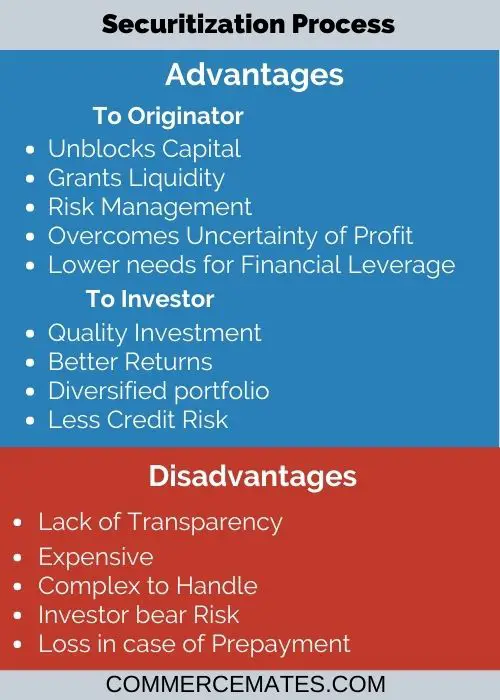Contents
Meaning of Securitization
Securitization is a process where various financial assets/debts of the firm are clubbed together into a consolidated financial instrument for trading in the financial market. It converts the assets into tradeable securities that carry interest which are sold to investors such as bonds and stocks. In simple terms, it is a method which free up the blocked capital of firm by transforming the illiquid assets into liquid assets. Securitization is an efficient tool which enhances the overall liquidity in market by acting as a source of funds especially for financial companies. In addition to this, it offers better investment opportunities to investors with diversified portfolio offering quality returns. Securitization generally takes place with loans and assets that generates receivables like commercial or consumer debt.
Process of Securitization
Process of securitization is a very complex and lengthy process that comprises of various stages and involving different parties.
These steps are discussed in detail as given below: –
- Identification Process: First stage in the process of securitization is termed as identification process. Financial institution which chooses to go for securitization of its assets is called originator. In this stage, originator selects a pool of assets of homogenous nature in terms of rate of interest, maturity period etc.
- Transfer Process: This is the second stage of securitization where transformation process of converting the selected pool of assets into securities takes place. Once the pool of assets to be securitized is identified by originator, then it is passed on to another institution known as Special purpose vehicle (SPV) or trust. Outright sales basis is the manner in which pass through transaction takes place in between the originator and SPV. The selected assets are removed from the balance sheet of originator as soon this transfer process takes place.
- Issue Process: In this process, SPV does the task of converting the pooled assets into tradeable securities for issuing them to investors. The package of assets is split into individual securities of smaller denominations by SPV for selling them to public. SPV gets its fees for carrying out these functions out of the sale process of these securities. The securities are issued in various forms such as “Pay through certificates”, “Interest only certificates”, “Principal only certificate” and “Pass through certificates”. Structure of these securities is created in such a way that maturity of these securities and maturity of securitized receivables synchronies with one another.
- Redemption Process: Redemption process is concerned with interest payments and redemption of issued securities by SPV via collections from securitized assets. Collection of dues related to securitized assets is either done by originator himself or a special service agent is appointed who charges commission for this work. SPV plays a major role in processing all payments related to interest and principal to the investors. A pass through certificate is issued either with recourse and without recourse certificate. If securities are issued with recourse, in that case SPV will held the originator liable in case of any default payments.
- Credit Rating Process: It is the process in which passed through certificates is granted a credit rating by rating agencies to make it more attractive. It is the last stage in securitization process which improve the credit worthiness of certificates to increase their acceptability to investors. This credit rating agency gives guarantee to investors for timely payment of interest and principal by SPV.
Types of Securitization
There are distinct types of securitization which is determined in accordance with type of receivables. Common types of securitization are explained below: –

- Asset-Backed Securities (ABS): Asset-Backed securities are the bonds backed by underlying financial assets. Credit card debts, auto loans, home-equity loans and student loans are various types of receivables that are converted into ABS.
- Commercial Mortgage-Backed Securities (CMBS): These are bonds that are backed by pool of commercial assets mortgage like industrial land, factory, plant, office building etc.
- Residential Mortgage-Backed Securities (MBS): Residential Mortgage-Backed Securities are those bond which are secured by mortgage of house, jewelry, land, property and various other valuable belongings.
- Collateralized Debt Obligations (CDO): These are bonds which are designed out of re-pooling the personal debts for marketing in secondary market for investors.
- Future Flow Securitization: These are the securities issued against the future debt receivables. All principal and interests are met by company out of its routine business activities.
Advantages of Securitization Process
There are several parties involved in process of securitization which gets benefited through this process. Originator and investor are two major parties who have major advantages which are discussed below: –
To Originator
- Unblocks Capital: Major advantage of securitization to originator is that free its locked capital by liquidating its assets. The originator is able to get its lent funds much before the maturity.
- Grants Liquidity: It provides liquidity by converting the illiquid assets into liquid ones which assists in acquiring requiring funds timely.
- Risk Management: Financial companies can easily lower the risk by securitizing the amount lend by them which reduces the chances of bad debts.
- Overcomes Uncertainty of Profit: This process enables in overcoming profit uncertainty by securitizing doubtful obligation which reduces the chances of losses.
- Lower needs for Financial Leverage: This process by unblocking the capital helps in regulating liquidity of company due to which originator does not need to go for financial leverage for meeting its needs.
To investor
- Quality Investment: Securitization offers wise investment options which grants reliability to investors by providing Mortgaged and Asset backed securities.
- Better Returns: Investors get access to superior returns through the process of securitization. It offers securities of companies enjoying better market position.
- Diversified portfolio: Securitized bonds provide investors a well-diversified portfolio that is created via pooling of company’s assets. These instruments are distinct from other classes of investment.
- Less Credit Risk: The assets which are offered through the process of securitization carries a less degree of credit risk as they are rated by good credit rating agencies. Such assets have higher creditworthiness in market.

Disadvantages of Securitization Process
There are various drawbacks of this process which are explained below: –
- Lack of Transparency: Securitized bonds lacks transparency as it does not reveal the details of assets included in these bonds. SPV does not disclose such details to investors.
- Expensive: Expenses associated with securitized bonds is higher as compared to share floatation. Various cost comprises of legal, underwriting, administration and rating charges.
- Complex to Handle: Process of securitization is much complicated to handle as it involves multiple parties. A pool of assets needs due attention for creating a well-diversified portfolio.
- Investor bear Risk: Investor may end up in high amount of losses in case the borrower fails to repay its debts. In such a case, investor will be sole risk-bearer.
- Loss in case of Prepayment: Investor may suffer losses and not able to generate superior gains in case of prepayment of debts by borrower.
Conclusion
Investors do not find the process of securitization as an excellent opportunity of investment as it involves a high degree of risk even after being secured by collateral security.
However, an investor may generate higher amount of returns if creditworthiness of borrower is properly evaluated and proper analysis of available investment opportunity is made.